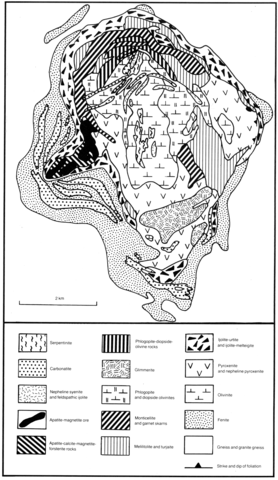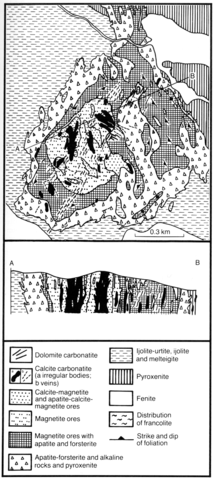stripes
The Kovdor complex has a drop-like shape in plan and its area is about 55 km2. It is related to an east-west fracture system (Kukharenko et al., 1971) and intrudes granite gneisses of Archaean age. It is a composite, multiphase intrusion with a concentric zonal structure. The following rock suites have been mapped from oldest to youngest: (1) ultrabasic rocks including olivinites and pyroxenites, (2) alkaline rocks of an ijolite-melteigite series, (3) melilite rocks, (4) a complex of apatite phoscorite rocks and magnetite ores, (5) carbonatites and (6) nepheline syenites. The olivinites are located in the central part of the complex and they have been detected gravimetrically down to a depth of 7-10 km. The olivinites contain inclusions of titanomagnetite, and include apatite and calcite. Almost everywhere the olivines have been subjected to a process of phlogopitisation. Pyroxenites envelope the olivinite body on the southern and western sides forming a discontinuous zone 1-1.3 km in width. The pyroxenites are variable in grain size and have aggregates of titanomagnetite, and they are completely phlogopitized and amphibolized, particularly where in contact with the alkaline rocks. Pyroxenites are often observed in the olivinites as veins, and sometimes pyroxene-olivine rocks, which are essentially phlogopitized, are developed. The phlogopite which is mined for industrial purposes comes from these rocks, and individual crystals may reach several metres in diameter. The alkaline rocks of the Kovdor complex are represented by ijolites, melteigites and nepheline pyroxenites with a subordinate part played by urtites and ijolite-urtites; ijolites, malignites and nepheline syenites are relatively insignificant. The rocks of the ijolite-melteigite series (Volotovskaya, 1960) form a conical intrusion which is developed as a discontinuous ring around the central massif of ultrabasic rocks. At the present level of exposure the width of the circle of alkaline rocks ranges from 100 to 800 m. Melilitic and monticellitic rocks form a semicircular zone up to 1 km wide between the ultrabasic and alkaline rocks as well as several rather small bodies amongst the ijolites and pyroxenites. These rocks have very mixed mineral compositions and are heterogeneous in texture and structure. They include turjaites, pyroxene turjaites and melilitites. Less commonly found are monticellite, melilite-pyroxene and melilite rocks with olivine. The 'ore complex' of the Kovdor massif (Fig. 30) is situated in the southwestern part and consists of apatite-forsterite rocks and magnetite-rich ores which form an elongate body of 0.8x3 km. The ore complex comprises the following series (a) forsterite, apatite-forsterite and apatite-phlogopite-forsterite rocks, (b) rocks containing a high proportion of magnetite and including apatite, forsterite and phlogopite and (c) ores consisting essentially of apatite and including magnetite-apatite and calcite-apatite rocks. The most characteristic accessory mineral of the magnetite ores is baddeleyite. Carbonatites of the Kovdor massif are represented by two varieties: calcite carbonatites, comprising bodies 100 to 500 m in diameter, and dolomite carbonatites, which form the greatest number of veins, that vary from 0.7 to 1 m wide. The main minerals of the calcite carbonatites are calcite, apatite, magnetite, phlogopite and pyrrhotite with subordinate forsterite, actinolite, tremolite, hastingsite, diopside, aegirine-diopside, andradite, wollastonite, ankerite, chalcopyrite, pyrochlore, baddeleyite, zircon, zirconolite and dysanalyte. The dolomite carbonatites comprise 90-98% dolomite with calcite, apatite, strontianite, vivianite, zircon, baddeleyite, pyrochlore, dysanalyte, lueshite, magnetite, phlogopite and vermiculite. Kononova and Yashina (1984) have determined delta18O and delta13C values for calcite from calcite carbonatite of +8.7 and -3.6 and for calcite-dolomite carbonatite of +7.6 and -3.4 respectively. So/oo for sulphides from calcite carbonatite vary from -2.4 to -4.5 and from dolomite carbonatite gave a value of -6.4 (Grinenko et al., 1970). Details of dolomite-calcite textures, which are utilised for geothermometry, are described by Zaitsev and Polezhaeva (1994). Nepheline and cancrinite syenites form a series of small veins which cut all the other rock types, including the carbonatites. Some authors (Kukharenko et al., 1965) consider that the melilitites and rocks of the ore complex are of metasomatic origin. Analyses of melteigites, ijolites and urtites and their rock-forming minerals will be found in Kononova (1971) and Kononova et al. (1965 and 1975). Major and trace element data on carbonates, and their thermoluminescence characteristics, are given and discussed by Sokolov (1985), and the same author (Sokolov, 1973) using the Mg contents of coexisting clinopyroxene and mica, estimated the temperature of formation of carbonatites and a range of silicate rocks. Epshteyn and Danil'chenko (1988) review the stages of emplacement, rock-forming minerals and principal rock types and their spatial distribution and conclude that replacement rather than magmatic injection was an important process in genesis, particularly for the apatite-magnetite ores. Kharlamov et al. (1981) discuss the origin of the carbonatites based on examination of primary melt inclusions.
BAYANOVA, T.B., KIVNARSKYI, Yu.M., GANNIBAL, A.F., KOSHEEV, O.A. and BALASHOV, Yu.A. 1991. U-Pb dating of baddeleyite from the Kovdor carbonatite massif. In Abstracts of All-Union School Seminar 'Methods of isotope geology'. 21-25 October, 1991. Zvenigovod, St Petersburg. 31.
EPSTEIN, E.M. and ANIKEEVA, L.I. 1963. Some aspects on geology and petrology of the ultrabasic rocks complex. Physical-chemical problems of the formation of ore. Doklady Akademii Nauk SSSR,11: 182-96.
*EPSHTEYN, Y.M. and DANIL'CHENKO, N.A. 1988. A spatial-genetic model of the Kovdor apatite-magnetite deposit, a carbonatite complex of the ultramafic, ijolite and carbonatite rock association. International Geology Review, 30: 981-93.
*EPSHTEYN, Y.M. and DANIL'CHENKO, N.A. 1988. A spatial-genetic model of the Kovdor apatite-magnetite deposit, a carbonatite complex of the ultramafic, ijolite and carbonatite rock association. International Geology Review, 30: 981-93.
GRINENKO, L.N., KONONOVA, V.A. and GRINENKO, V.A. 1970. Isotopic composition of sulphur of sulphides from carbonatites. Geokhimiya1: 66-75. Geochemistry International, 645-53.
*ILYIN, A.V. 1989. Apatite deposits in the Khibiny and Kovdor alkaline igneous complexes, Kola Peninsula, north-western USSR. In A.J.G. Notholt, R.P. Sheldon and D.F. Davidson (eds), Phosphate deposits of the world. 2. Phosphate rock resources. 485-93. Cambridge University Press. Cambridge.
*IVANENKO, V.V. and KARPENKO, M.I. 1988. 39Ar-40Ar data on excess argon-40 in nepheline from the Kovdor massif, Kola Peninsula. Geochemistry International,25(1): 77-82.
*KHARLAMOV, Ye.S., KUDRYAVISEVA, G.P., GARANIN, V.K., KORENNOVA, N.G., MOSKALYUK, A.A., SANDOMIRSKAYA, S.M. and SHUGUROVA, N.A. 1981. Origin of carbonatites of the Kovdor deposit. International Geology Review, 23: 865-80.
KONONOVA, V.A. 1971. On the role of the magmatic and metasomatic processes for the origin of the melteigite-urtite series of rocks. In A.I. Tugarinov (ed) Geochemistry, petrography and mineralogy of alkaline rocks. 35-52. Nauka, Moscow.
*KONONOVA, V.A. and SHANIN, L.L. 1971. On the possible application of nepheline for alkaline rock dating. Bulletin Volcanologique, 35: 1-14.
*KONONOVA, V.A. and YASHINA, R.M. 1984. Geochemical criteria for differentiating between rare-metallic carbonatites and barren carbonatite-like rocks. Indian Mineralogist, 136-50.
KONONOVA, V.A., ORGANOVA, N.I. and LOME'KO, E.I. 1965. On the composition and temperature of the nepheline crystallization from the ijolite-melteigite series of rocks. Izvestiya Akademii Nauk SSSR, Seriya Geologiya, 7: 65-73.
KONONOVA, V.A., LAPUTINA, I.P., LOME'KO, E.I. and TIMOFEEVA, I.A. 1975. Typomorphic features of the rock-forming minerals from the jacupirangite-urtite series of rocks. Izvestiya Akademii Nauk SSSR. Seriya Geologiya, 7: 45-58.
KUKHARENKO, A.A., BULAKH, A.G., IL'INSKY G.A., SHINKAREV, N.F. and ORLOVA, M.P. 1971. Metallogenic peculiarities of alkaline formations of the eastern part of the Baltic shield. Trudy Leningradskogo Obshchestva Estestvoispytatelei, 122 (2): 278 pp.
KUKHARENKO, A.A., ORLOVA, M.P., BULAKH, A.G., BAGDASAROV, E.A., RIMSKAYA-KORSAKOVA, O.M., NEPHEDOV, E.I., IL'INSKII, G.A., SERGEEV, A.S. and ABAKUMOVA, N.B. 1965. The Caledonian complex of ultrabasic alkaline rocks and carbonatites of the Kola peninsula and north Karelia. Nedra, Moscow. 772 pp.
*SMIRNOV, V.I. 1989. European part of the U.S.S.R. In F.W. Dunning, P. Garrard, H.W. Haslam and R.A. Ixer (eds). Mineral deposits of Europe. 4/5: Southwest and eastern Europe, with Iceland. 279-407. The Institution of Mining and Metallurgy and The Mineralogical Society, London.
*SOKOLOV, S.V. 1973. A geothermometric study of carbonatite complexes. Geochemistry International, 10: 1110-6.
*SOKOLOV, S.V. 1985. Carbonates in ultramafite, alkali rock, and carbonatite intrusions. Geochemistry International, 22(4): 150-66.
*ZAITSEV,A. and POLEZHAEVA, L. 1994. Dolomite-calcitetextures in early carbonatites of the Kovdor ore deposit, Kolapeninsula, Russia:their genesis and application for calcite-dolomitegeothermometry. Contributions to Mineralogy and Petrology, 115: 339-44.


